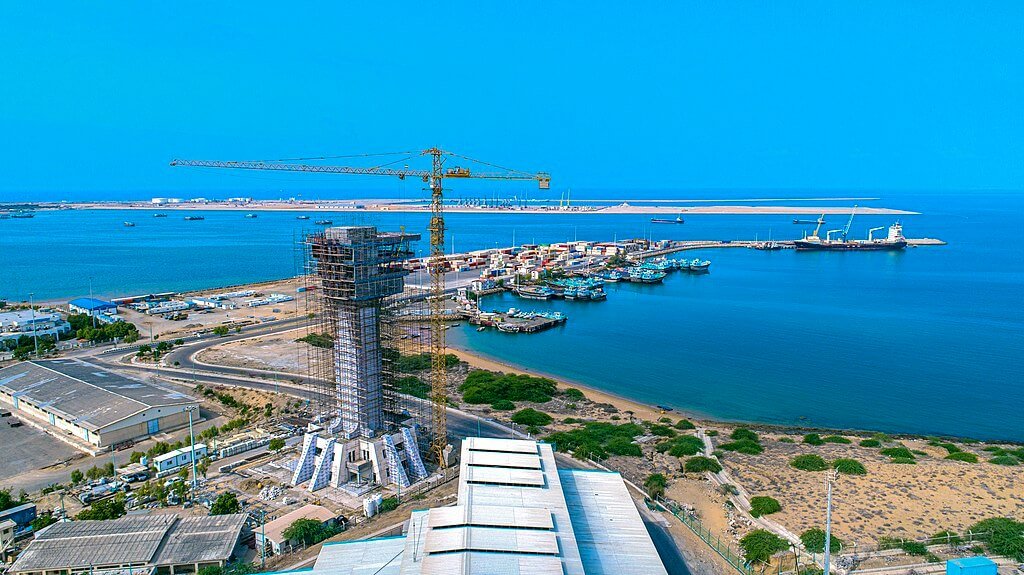Editor’s Note: Mohammad Salami is a young Pakistani academic and frequent contributor to Stimson who closely follows Iran and its regional policies, particularly in the economic and security realms. Chabahar port is a major issue for both Iran and Pakistan, which is promoting a rival port at Gwadar.
By Barbara Slavin, Distinguished Fellow, Middle East Perspectives
In May, Indian Minister of Ports Shipping and Waterways Sarbananda Sonowal and Iranian Minister of Roads and Urban Development, Mehrdad Bazrpash, signed a 10-year agreement for the operation of Chabahar port on the Gulf of Oman in southeastern Iran. Under the agreement, India is to invest $120 million in the development of infrastructure in the Shahid Beheshti terminal at the port and extend a $250 million credit line to Iran.
India made the agreement with the aim of boosting trade with landlocked Afghanistan and Central Asian countries. By equipping and leasing Chabahar port, India could meet several other goals, including bypassing China, competing with Pakistan’s nearby Gwadar port and influencing Afghanistan. However, challenges remain including U.S. economic sanctions and potential tensions with China and Pakistan despite their otherwise good relations with Tehran.
A major impediment is U.S.-backed sanctions against Iran, including Iran’s blacklisting by the Financial Action Task Force (FATF), a global watchdog against money laundering and terrorism-financing, and Iran’s lack of access to the SWIFT system of electronic international payments. Iran is also barred from conducting transactions in dollars. Iran’s new president, Masoud Pezeshkian, campaigned in part on these issues but his ability to resolve them remains in doubt.
There are also logistical obstacles, such as Iran’s delay in completing two railway lines –Chabahar-Zahedan and Rasht-Astara — which are necessary for moving cargo from the port and connecting to a planned International North–South Transport Corridor (INSTC).
Another question involves China. In 2021, China and Iran signed a 25-year, $400 billion partnership agreement. This fueled speculation that China would invest in Chabahar or in both Chabahar and Gwadar, which are only about 100 miles apart. There is room for Chinese involvement in Chabahar since India has only invested in the Shahid Beheshti wharf and Shahid Kalantari terminal there.
So far, however, Tehran has not received the support from Beijing it anticipated.
China invested only $618 million in projects in Iran from 2018 to 2022, mainly in the construction sector. Meanwhile, China invested $22.5 billion in Saudi Arabia, $13 billion in Iraq, $4.6 billion in Kuwait, $1.8 billion in Qatar, $19.3 billion in the United Arab Emirates (UAE), and $2.5 billion in Oman. Even China’s investment in tiny Bahrain was more than twice what it put into Iran.
Iran has also been irritated by Chinese diplomatic stances. In a recent meeting with Arab states, China signed off on a communique that disputed Iranian control of three small islands in the Persian Gulf that are also claimed by the UAE. Iran summoned the Chinese ambassador to Tehran to protest but China’s foreign ministry spokesman reaffirmed Beijing’s position that the UAE and Iran should resolve their differences through negotiations.
Competition between Chabahar and Gwadar is also significant.
China has committed to investing $62 billion in Gwadar port, while India will invest less than $500 million in Chabahar. In addition, the projected capacities of the two ports are significantly different. It is expected that by 2030, Gwadar will handle up to 400 million tons of cargo per year, much more than Chabahar’s projected capacity of 10 to 12 million tons.
Gwadar, which is located in southwest Pakistan, is intended to be connected to the Xinjiang region in China’s northwest through a network of roads, railways, and pipelines.
The U.S. position on Chabahar has fluctuated, with tacit support while U.S. troops were still in Afghanistan but less interest since the U.S. withdrawal from that country in 2021 and the return of Taliban control. A few hours after India signed the contract with Iran, State Department deputy spokesperson Vedant Patel warned Indian authorities that “anyone considering business deals with Iran needs to be aware of the potential risk of sanctions.”
On the other hand, the U.S. considers Chabahar as useful to counteract China’s Belt and Road Initiative (BRI). The U.S. is trying to weaken and marginalize a Chinese international transportation project that extends to Central Asia, Russia, and European countries through Pakistan while supporting initiatives that start from India and extend through Iran and Central Asia to Europe. For this reason, the U.S. may ignore whatever economic gains Iran derives from Chabahar.
For India, Chabahar could provide a hedge against U.S. economic pressure. Aiming to
become the third-largest economy in the world by the end of the decade, India is a member of BRICS and the Shanghai Cooperation Organization and imports Russian oil despite Western sanctions over the Russian invasion of Ukraine. India also did not join a U.S.-led operation to protect shipping in the Red Sea from Houthi attacks tied to the Gaza war.
India has also sought to balance relations with Iran and Israel. At the same time New Delhi signed the Chabahar agreement, India’s Adani Group invested $1.2 billion in Israel’s Haifa port.
For Iran, any foreign investment is welcome. Burdened by sanctions, corruption, and mismanagement, Iran is ranked by the World Bank as among the world’s poorest countries in terms of logistics performance. Last year, the Islamic Republic was ranked 123 out of 139 countries on this index, the lowest among its neighbors except for Afghanistan. Even Iraq ranked higher than Iran at 115.
Mohammad Salami is a research associate at the International Institute for Global Strategic Analysis, an Islamabad-based think tank. His areas of expertise include politics and governance, security, and counterterrorism in the Middle East, especially the Persian Gulf. Follow him on Twitter @moh_salami.
